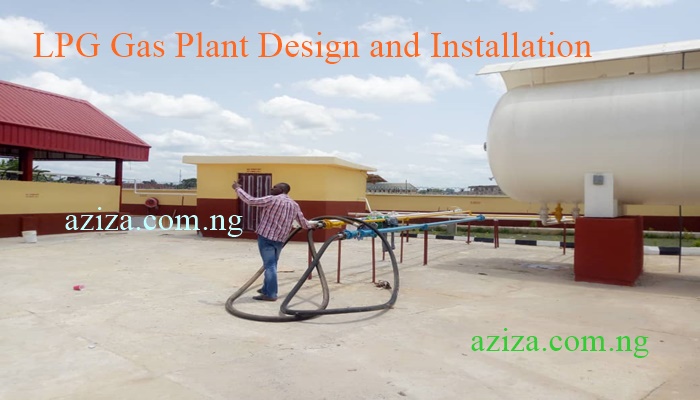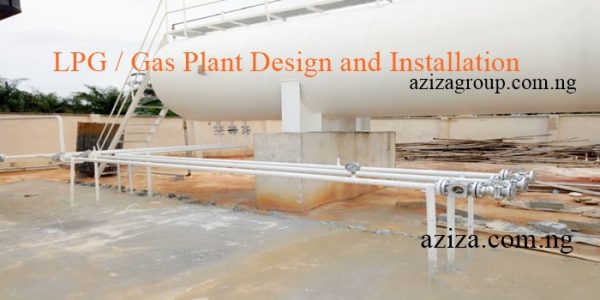In this post, we explained regulatory LPG / Gas filling Station Construction (Design and Installation) requirements, Cylinder Filling Shed requirements and Requirements for LPG Plant/ Cooking Gas Plant Licence and Permits. For your engineering design and construction, contact Aziza M. E. & S Limited.
Read: LPG / Gas Plant Design and Installation.
LPG filling Station or Gas filling Station business is a lucrative oil and gas business in Nigeria and other parts of the world. LPG or Gas filling Station business is capital intensive business. The cost of the business ranges from land acquisition, to relevance authorities’ site approvals, to buying or constructing LPG storage tanks. It continued to construction of the LPG filling Station or Gas filling Station and then buying of the product(s) to sale.
Gas filling Station construction is a vital stage of LPG business. You need an experience team to do the construction. The benefits of using an experienced team is enormous. It saves you from waste of time, material and cost. It also helps you to minimize cost of maintenance when the Gas filling Station is in operation. Aziza MES Limited is a good and experience team to choose for your LPG (Gas) filling Station in Nigeria.
Three (3) Stages to go:
– Suitability Approval (to know if your land location is good)
– Approval to Construct – ATC (to approve your stucture)
– License to Sale (permit/ license to operate an LPG plant)
Read: LPG Tanks Fabrication & Manufacture
What is LPG?
LPG: is Liquefied Petroleum Gas or liquid petroleum. Liquefied Petroleum Gas – LPG – constituents are primarily propane, butane, isobutane, butylene, propylene and mixtures of these gases. LPG gas constituents are produced from crude oil reefing and natural gas processing. They are liquid under pressure and gas at room temperature and pressure.
Liquefied Petroleum Gas (LPG) is mixture of flammable hydrocarbon gases that include propane, butane, isobutane and mixtures of the three LPG gases. LPG is commonly used for home heating gases, cooking, hot water, and autogas – fuel for LPG cars and vehicles.
Read: How to Apply for DPR Permits & Licenses on Gas or LPG
Before any body or organization owns LPG plant or Gas plant, there are standered requirements you must meet that will be approved by Nigerian Midstream and Downstream Petroleum Regulatory Authority (NMDPRA).
General Design:
The design of vessels, vessel fittings, pumps, dispensing systems, hoses, filling nozzles and adaptors and breakaway/pull-away systems should be designed for efficient and safe operations in line with applicable codes and standards.
Read: How to Start LPG/ Gas Business in Nigeria
Very Important Things to note before starting LPG / Gas Plant Design and Installation
Local Content:
Company shall demonstrate sufficient commitment to ensuring that all aspects of the project that can be competently executed locally are handled by Nigerian contractors. Click to read Local Content Registration and Local Content Acts.
Nigerianisation:
Project Management structure shall be composed in a manner that shall reflect the indigenization policy of the government.
The Department of Petroleum Resources shall attach relevant personnel to participate in all the different phases of the project development.
Zero-Flare compliance:
All project development programs shall be established with an objective amongst others of complying with the directive of the government, on the elimination of routine operational flaring of associated gas by 1st of January 2008.
Green House Gases
The use of green house gases- Chloro-Flouro Carbon (CFCs) e.g. Helon in fire fighting systems is prohibited in line with commission environmental guideline and standards for the Petroleum Industry.
Use of Chemicals
The use of chemicals for oil and gas production operations shall comply fully with the requirements of the national environmental guidelines and standards for the petroleum industry as issued by the Department.
Handling of Hazardous Materials
The use and handling of hazardous materials for oil and gas production operations shall comply fully with the requirement of the national environmental guidelines and standards for the petroleum industry as issued by the Department Material Safety Data Sheets (MSDS) shall be compiled and approval obtained from the Department before use.
Installation:
The installation and commissioning of the LPG or Gas Plant should only be undertaken by competent personnel, and in accordance with manufacturer’s instructions.
Written procedures should be drawn up for installation and/or commissioning. Mineral Oils Safety Regulations (MOSR), 1997 should be observed in these installations, particularly the taking of all the necessary measures to reduce risk as much as reasonably practicable, including the replacement of the hazardous by the non-hazardous or by the less hazardous.
LPG or Gas Storage Tank Design Specifications and Fittings.
(a) All tanks for the storage of liquefied petroleum gas shall be designed for a working pressure corresponding to the vapour pressure and at the highest temperature that the tanks are likely to reach.
(b) All storage tanks should be fitted with the pressure gauge and devices for measuring the liquid content and its temperature. The maximum quantity of LPG filled into any tank should be such that the maximum operating temperature it would occupy shall not be more than 95% of the capacity of the storage.
(c) Excess flow valve should be fitted to prevent the loss of liquefied Petroleum gases from storage tanks, transport tanks and points where flexible hoses are used.
(d) Remote control hydraulically operated shut-off valves should be fitted to each storage tank.
(e) Water sprinkler system should be provided on top of the gas vessel. Access ladder to the top of the gas storage should be provided for inspection and maintenance needs.
Read: LPG Business Opportunities in Nigeria
Cylinder Filling Shed.
(a) Cylinders should be filled with LPG only in building designed for that purpose. Filling buildings should be open-sided. The filling of cylinder: should not be done in cellars of upper story of building.
(b) Floor should be near ground level or raised to a minimum of 1 meter to vehicle platform height.
(c) A fence of at least 2 meters high should be provided to enclose the filling and gas storage area if the filling is not carried out within a fenced area.
(d) No duct or blow-off line should be directed into or discharged near sewer systems or drains used for other purposes.
(e) Water drains from the filling area should be provided with effective seals.
(f) Piping should be protected or painted in appropriate industrial colour.
(g) Fire extinguisher in sufficient quantity should be provided at strategic places within the premises and the plant personnel should have easy access to the extinguisher.
(h) Cylinders should not be stored in the cylinder filling area. An area within the plant should be designated for cylinders storage.
(i) Adequate lighting should be provided to illuminate the working and the storage areas of the plant.
Requirements for LPG Plant/ Cooking Gas Plant Licence
The following requirements are to be met before approval, construction, modification, relocation and licence of a Liquified Petroleum Gas (LPG) plant and auto gas station by Director of Petroleum Resources (DPR) in Nigeria.
- Three copies of the approved drawings showing the existing or proposed buildings on the site and the relevant distances to the
roadways and adjoining properties, if any.
The drawing include:
– Architectural Drawing
– Structural Drawing
– Mechanical Drawing
– Electrical Drawing - Three copies of Piping and Instrumentation Diagram (P&ID) of the gas filling plant and manufacturers’ data sheet of the storage tanks with codes and standards adopted in the design.
- A provisional approval letter and fire report by Chief Federal/State Fire officer or an officer authorized by him on his behalf, that he is satisfied with the proposed arrangement for the prevention of fire.
Note: This approval must come from state where the LPG station will be situated. - A letter from the appropriate Town Planning Authority, authorizing siting of the Liquefied Petroleum Gas filling plant at the proposed site. The Town Planning approval stamps on all design drawings are accepted.
- Three copies of Memorandum and Articles of Association of the company and evidence that the company is duly incorporated by
the Federal Ministry of Trade to deal in petroleum products. - Tax clearance certificate for the preceding three years of application or Tax exemption certificate for new company.
- An application fee, as may be determined by DPR, in Bank draft or certified cheque made payable to “Federal Government of Nigeria DPR Fee Account” is payable on submission of application.
- Three copies of Codes, Standards and Specification adopted in the design of the tanks and ancillary equipment.
- A copy of Safety, Health and Environment (SHE) proposal for the proposed plant and Environmental Impact Assessment report of the site.


